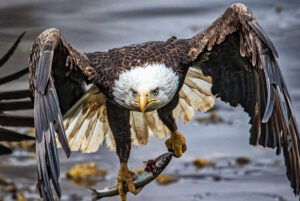
“So you’re going to Dutch Harbor?” a friend asked, his eyes bright with excitement. “We went there a couple years ago and were shocked by how many Bald Eagles we saw. There were posted signs to be aware of eagles on nests because they’ll attack you and rip out your eyes.”
We were unfamiliar with the port city of Unalaska, straddling a pair of islands on the body of water comprising Dutch Harbor. There were, indeed, many Bald Eagles. In fact, there were eagles in every imaginable condition, age, and location. But nests we didn’t see because, where we’re from, eagles build massive constructions of sticks and brush near the tops of tall trees. The odd thing about Unalaska is that there aren’t any trees. Sure, there’s a National Historic Landmark honoring a small grove of Sitka Spruce planted a couple hundred years ago by Russian colonizers. Their effort at a sustainable source of building material never materialized due to the area’s 250 days of annual rainfall and the sometimes gale-like winds. These conditions are unwelcoming to anything more than shrubby willows and the occasional conifers that never exceed more than 10′. With such a large population of Bald Eagles there obviously was nesting going on somewhere, and during our 5-day visit we spotted no fewer than 5 nests built high atop craggy cliffs bordering the shoreline. Or in tall grasses in quiet bays. Or on rocky outcrops adjacent to a road. All apparently successful and we were wary of getting too close.
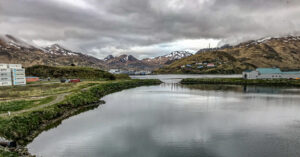
Unalaska, with a population of 4,750, is located on Unalaska and neighboring Amaknak Island way out in the Aleutian Islands. If Alaska Air flew the route, perhaps an hour or more would be cut off the 4-hour flight and the annoying refueling stop wouldn’t be necessary. But, alas, only Raven Air handles the route, and a combination of their small planes and the region’s snarky weather makes travel unpredictable. The two islands comprising the town of Unalaska are connected by a bridge, and in minutes we’d be exploring wilderness out of “town” in our rental car. And there the beauty began—an endless panorama of stunningly beautiful country, snow-capped peaks in the distance, and flowering plants, grasses, herbage, and shrubs giving the islands a warm hue. During our exploration, mopping along at 15mph, we spotted 34 bird species and captured nearly as many images.
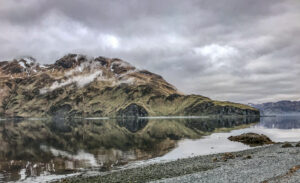
This pretty much is what we did, all day, every day. Being our first stop on this Alaskan adventure, we were unprepared for the constant sunlight—we could bird 20 hours-a-day if we wanted—so scheduling meals initially became challenging. From our room in the Grand Aleutian Hotel, we looked down onto the poop-stained deck adjacent to the restaurant that had been commandeered by the eagles. 10-20 of them would perch on the rails, and some bored quarantined idiots would toss bits of cheese dogs that the birds found tasty and tussled over. But cheese dogs weren’t on our munchy list and we soon discovered the Norwegian Rat Saloon.
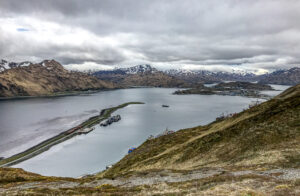
The Norwegian Rat, a bar and pizzeria across the street from our hotel, was the source of great eats and fun conversations. In fact, we’d barely passed through the insulated front door when a ship’s bell rang announcing free drinks contributed by a generous patron. Draft IPA in hand, I spent a moment with my benefactor and learned that he was the chief engineer on a supply ship docked way out in the lagoon. They were contracted to provide support to a military surveillance craft keeping watch on the Ruskies. That reinforced the fact that we were only a stone’s throw from the Russia. They were celebrating something, and everyone was more than willing to share their favorite places to visit in Unalaska. The clear favorite was up on Mount Ballyhoo. So the following morning we set off and climbed the 3-mile out-and-back switchback road while enjoying the eagles soaring beneath us and snowy peaks in the distance. After summiting the 897′ peak, we entered the hallowed remains of Fort Schwatka, the highest military post in the US. The fort, 800 miles west of Anchorage, was one of four coastal defense posts built to protect Dutch Harbor (crucial back door to the United States) during World War II. Amidst the snow-leveled wooden ruins, Terry spotted a brilliant Willow Ptarmigan, the male, and Sooney soon found the female munching away nearby. These are challenging birds to spot and contrasted nicely with the concrete bunkers characterizing the former military base that housed upwards to 1,000 troops during World War II.
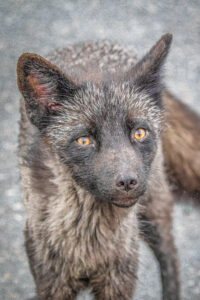
The owner of the Rat informed us that, in addition to humans, the only 2 mammals living on Amaknak Island are the Red Fox and rats. Hiking around Unalaska Island we spotted several noisy Arctic Ground Squirrels so I guess that makes three. Other species were either endemic or introduced, but have long been decimated by hunters for their fur or by the introduced fox population. We fortunately saw no rats, and the only foxes we encountered were domesticated and dependent on human handouts. One actually approached us and expressed confusion when no snacks were forthcoming.
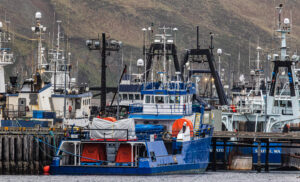
For more than 30 years, Unalaska’s economy has been based primarily on commercial fishing, seafood processing and marine transportation. Visitors are constantly reminded of a vibrant marine industry dependent on boats, supplies, and support. There are several marinas with dozens of huge boats, dry docks, welding shops, and container loaders handling the millions of cod, pollack, and crab caught during the two fishing seasons: winter (A) and early summer (B). Huge piles of crab pots are stacked in every available space, most with a compliment of eagles doing security. Ropes and nets of every size and color lie coiled like woven baskets. All this equipment requires an enormous work staff with semi-trucks and loaders at the ready to move from one location to the other. Not surprisingly, there were also the appearance of castaway machinery, structures, and vehicles slowly rotting or rusting away on the tide.
In addition, with the seasonal fishing schedule there is a desperate need of workers willing to live in dormitory conditions and staff the 12-14 hour shifts required of the processing plants. With the “B” season soon to begin, contract workers filled the plane and upon arrival we observed them being shuttled off to vaccination stations and quarantined to quarters to prevent a catastrophic return of COVID-19 that slammed the community in January. I learned that these jobs require unskilled workers whose primary task is to keep the fish pointed in the right direction—one after the other. The non-stopping conveyer belt feeds the robots that “head ’em, gut ’em, and filet ’em.” The remnants from this process is then trucked to the land fills with the awaiting crowd of fans: Bald eagles. Sadly, some industrial waste has contaminated the bay, and none of the local seafood is suitable for eating. In fact, the seafood in Dutch Harbor is deadly; a resident recently ate some freshly caught mussels and fell into an anaphylactic shock that killed her. So we played safe and hung out at “The Rat.”
Our 5 packed days completed, we prepared our departure early Friday morning. Bags packed and stuffed into our rental SUV, we attempted to drop off our vehicle only to discover a locked door. This was awkward, so Sooney knocked on the door and a teenager responded indicating that the staffer, Brenda, was sick wouldn’t be in. OK, so we gave him the keys, briefly prayed the deal finished, and proceeded to the gate. Everything worked out, and we appreciated how island transactions were backed by trust and a fair bit of luck. Meanwhile, small planes are dependent on weight, balancing, and weather, and we climbed onto the scales wearing our backpacks to validate our seating assignments. Without much fanfare, we flew non-stop to Anchorage. It’s a good thing having the wind in your sail, and on we proceed to our next visit to Nome.
I’ve compiled a collection of photos into a slideshow that will help us remember the beauty of Unalaska.
[embed-google-photos-album link=”https://photos.app.goo.gl/68qkqPx3mqkTHDGv7″ delay=”10″]
